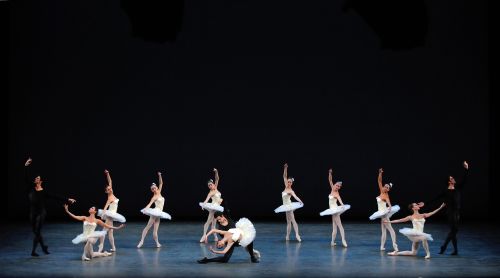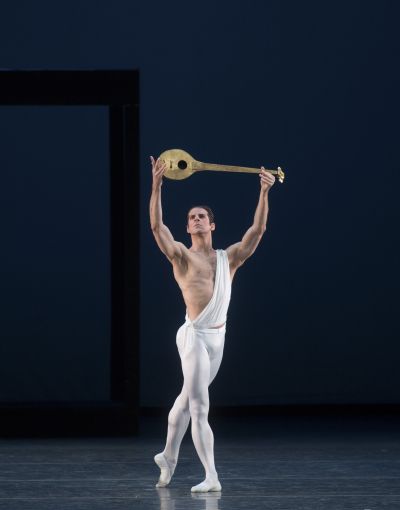 United States George Balanchine, Alexei Ratmansky, Dorothy Chandler Pavilion, Los Angeles, 11.7.2013 (JRo)
United States George Balanchine, Alexei Ratmansky, Dorothy Chandler Pavilion, Los Angeles, 11.7.2013 (JRo)
George Balanchine: Apollo, Symphony in C
Alexei Ratmansky: Chamber Symphony: American Ballet Theatre

In Balanchine’s ballet “Apollo,” Terpsichore reveals dancing to the world. And in the process this ballet, choreographed in 1928, revealed Balanchine to be the twentieth century’s successor to Saint-Leon, Petipa, and Ivanov, infusing their classicism with a modernist simplicity, which allowed classical ballet space to breathe and grow. In their opening performance at the Dorothy Chandler Pavilion last night, American Ballet Theatre gave us not only “Apollo,” but also “Symphony in C,” allowing us to revel in Balanchine’s genius.
As Lincoln Kirstein, co-founder with Balanchine, of New York City Ballet said: “We forget that much of the ‘modernism’ of adagio movement in our classic dance derives directly from Apollon; that many ways of lifting women, of turning close to the floor, of subtle syncopation in the use of pointes, of a single male dancer supporting three women, were unknown before Apollon.” To see this ballet is to see not only the birth of Apollo, but also the birth of plastic purity in dance.
From the first crystalline chords of Stravinsky’s score, so beautifully played by the orchestra, composed mainly of L.A. Opera musicians, and conducted by Charles Barker, we are transported to a mythic world where gods are born and muses dance the creation of art. It is a world we wholly believe in without a step, a gesture, or a glance out of place. In the American Ballet Theatre production, staged by former NYCB dancer, Richard Tanner, we are given a robust Apollo danced by Marcello Gomes. In stature, he resembled an Olympian athlete – solid, strong, and capable. There have been more lithe and lanky Apollos, Jacques d’Amboise and Peter Martins leap to mind, but Gomes owned this role last night. With his black hair and imposing looks, he communicated the grace and imperiousness of a god, putting me in mind of figures painted on Greek vases. Apollo is a role that requires a dancer with enormous dramatic and physical range. We are taken from his birth and first steps through his youthful exuberance to his final status as an Olympic God. All this Gomes accomplished.

© The George Balanchine Trust. Photos by Rosalie O’Connor.
Melanie Hamrick as Calliope, representing poetry, and Devon Teuscher as Polyhymnia, representing mime, were at their most charming in the exhilarating coda. Paloma Herrera admirably danced the role of Terpsichore, the muse of dance; but there was that indefinable something that was missing from her interpretation – perhaps a lack of authority that is inherent in Terpsichore’s status as the spirit of dance. After all, it is her gift that Apollo treasures most, and she is the muse who offers him a glimpse into the infinite in that instant when she, poised on his knee, her back to the audience, stares into the beautiful, blue beyond.
In a well-programmed pairing, Alexei Ratmansky’s “Chamber Symphony” followed. However, one wondered whether this detracted from or enhanced Ratmansky’s efforts. Shostakovich’s “String Quartet No. 8” arranged by Rudolph Barshai, conducted by Ormsby Wilkins, and retitled, “Chamber Symphony Op. 110A” served as the mournful score – the composer’s ode to the victims of totalitarian regimes.
There was a striking parallel to Balanchine’s “Apollo” in the single male partnering of three women. Perhaps these women represented the “artist’s” muses – the “artist” or principal dancer performed by the very musical James Whiteside – or perhaps they represented Shostakovich’s three wives. Whether this was meant to be clear or ambiguous seemed up for grabs. I suppose one clue to this conundrum was to be found in the distracting set design of George Tsypin consisting of numerous tortured portraits, which massed on the upper reaches of the stage. But the backdrop only served to confuse the movement in the foreground, as did the dour colors of the costumes. One had to chase the action on the stage, clearing away the visual clutter.
There were rewarding moments, however, in the dancing of the three ballerinas: Isabella Boylston, Yuriko Kajiya, and the ever-luminous Julie Kent – in particular a section where Whiteside received a suffering Kajiya, propelled upwards by four male dancers into Whiteside’s arms, and then just as quickly reclaiming her, only to offer her again and again, a cruel joke on the tormented artist. Not all the proceedings were gloomy, however. There were moments of levity; and in fact, Ratmansky seemed at his best in these small, flirtatious moments where his individuality as a choreographer shined through.
The final offering of the evening was Balanchine’s resplendent “Symphony in C,” dating back to 1947, when it was originally called “Le Palais de Cristal” and choreographed for the Paris Opéra. This ballet is a veritable joy ride through the Balanchine technique, a thrillingly regal display of musicality and athleticism. And who better (along with Stacy Caddell), than the paragon of Balanchine technique and style, Merrill Ashley, to stage this gem. Composed by a youthful Georges Bizet, the music consists of four movements, each movement danced by a different pair of principals and accompanied by the corps. The vivacious score, conducted again by Ormsby Wilkins, propels the dancing. In the first movement a lovely Stella Abrera was masterfully partnered by Eric Tamm. In the second movement adagio with its exotic flavor, Veronika Part, despite her skills, was too controlled to achieve the abandon necessary to convey sensuality. In the third movement, Kajiya danced lyrically with an airborne Daniil Simkin who, with his wide grin and effortless technique, impressed. The fourth movement showed off the clarity of Sarah Lane’s dancing, partnered by Sascha Radetsky, whose dancing drove the ballet to its joyous conclusion.
It’s interesting to contemplate the Russian roots of both Ratmansky and Balanchine. The former brings with him the fascinating flavor of Soviet-era Russia laced with Chekhovian humor; the later brings us the imperial Russia of snow-laden forests, glowing with the purity of a painting by Malevitch.
ABT continues its Los Angeles engagement with performances of “Le Corsaire” through Sunday.
Jane Rosenberg